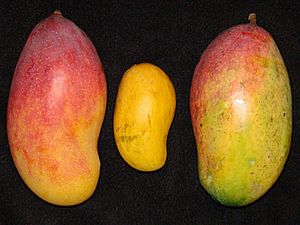Valencia Pride facts for kids
Quick facts for kids Mangifera 'Valencia Pride' |
|
|---|---|

2 ripe Valencia Pride mangoes from the Ghosh Grove, Rockledge, Florida are shown on each side of a store-bought Ataulfo mango
|
|
| Genus | Mangifera |
| Species | Mangifera indica |
| Hybrid parentage | 'Haden' x unknown |
| Cultivar | 'Valencia Pride' |
| Origin | Florida, US |
The Valencia Pride mango is a special type of mango that ripens later in the season. It first grew in south Florida.
How the Valencia Pride Mango Started
The very first Valencia Pride mango tree grew from a Haden mango seed. This seed was planted in 1937 by Mrs. Charles Brown in Miami, Florida. The tree started growing fruit in 1941. Scientists later studied its family tree in 2005 and found that the Haden mango was indeed its parent.
People started to notice the Valencia Pride mango because of its great looks, how much fruit it produced, and its delicious taste. Mr. and Mrs. Andrew Zapiain from Miami began to grow more of these trees.
Over the years, the Valencia Pride mango became popular all over Florida. People grew it in their homes and on farms. Even today, it is one of the most common mango trees sold in nurseries. It is still grown for sale in Florida, but in smaller amounts.
This mango has even been chosen as a "Curator's Choice" at the International Mango Festival held by the Fairchild Tropical Botanic Garden. This happened most recently in 2009.
You can find Valencia Pride trees in special plant collections. These include the USDA's plant collection in Miami, Florida. They are also at the University of Florida's Tropical Research and Education Center in Homestead, Florida. Another place is the Miami-Dade Fruit and Spice Park, also in Homestead. This mango also grows in the Coachella Desert in Mecca, California.
What Does the Valencia Pride Mango Look Like?
The Valencia Pride mango has a unique shape. It is long and thin, with a rounded bottom and top. It also has a noticeable point at the end. This mango is quite big, usually weighing over one pound when it's ready to eat. Some can even weigh up to two pounds!
The skin of the mango is yellow, and much of it is covered in a bright red color. Inside, the fruit is yellow, firm, and very juicy. It has almost no stringy fibers. The taste is sweet, and it has a lovely smell. Inside, it has one long seed.
In Florida, these mangoes usually ripen from July to August. This makes them a late-season mango. The trees produce a lot of fruit every year. The fruit is also pretty good at resisting fungus, which helps keep it healthy.
How the Trees Grow
Valencia Pride mango trees grow very quickly and strongly. They are known as some of the fastest-growing mango trees in Florida. If you let them grow without trimming, they can reach over 50 feet tall! They have big, open branches that spread out wide.

